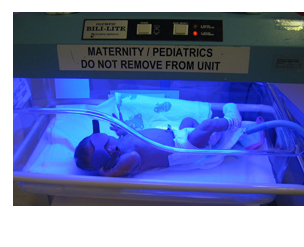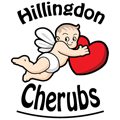|
Phototherapy
Haemoglobin is a component of red blood cells. In the womb, babies have a special 'fetal haemoglobin' which enables them to take plenty of oxygen from the mother. When they are born, this fetal haemoglobin is broken down and replaced by normal haemoglobin. When red blood cells are broken down, a chemical called bilirubin is released into the blood stream. Jaundice is yellowing of the skin caused by increased levels of bilirubin in the blood. This coupled with the immature liver function of a preterm baby, means that most premature babies will need blood tests to check bilirubin levels ('SBR') and phototherapy treatment for jaundice at some point.
 Jaundice is often seen in term babies too, mostly at a level that does not require phototherapy, although some term babies may need treatment.
Phototherapy is a blue or white light which breaks down bilirubin. It may be in the form of an overhead light (as shown) or as a 'biliblanket' (a thin strip of light that baby will lie on).
Babies undergoing phototherapy will be nursed naked, and have goggles covering their eyes to protect them from the bright light. Their position may be changed every few hours to maximise exposure to the light.
|



